Just 15 miles inland from the glitz of Biarritz and the seaside charm of Saint-Jean-de-Luz, the Pays Basque hinterland feels a world away. It’s here that the steep coastal cliffs give way to the craggy foothills of the Pyrenees. The houses and villages have a distinct architectural style that, if not for the car we’re zipping round the narrow country roads in, would convince me we’ve been teleported back in time. And there’s a deep-routed passion and pride in being French-Basque, evident in the friendly conversations you’re bound to have with the locals, like the Espelette pepper producer you’re buying some piment from or the proprietor at the family-run inn that’s been in his family for three generations. Often overshadowed by the surfing and thalassotherapy in Biarritz, the hinterland definitely shouldn’t be forgotten on your trip. From hiking past Pottok ponies to trying all the delights made with Espelette pepper, there’s plenty of things to do in French Basque Country…and we’ve only scratched the surface of the highlights.
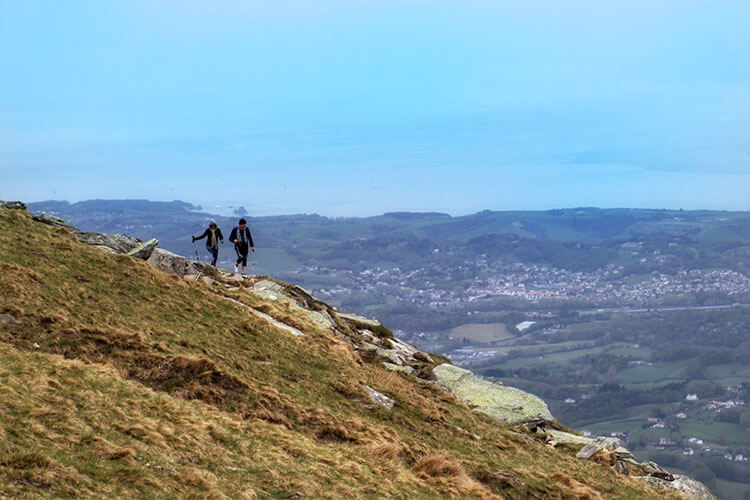
A Michelin-star meal at l’Auberge Basque | 8pm
San Sebastián may be world famous for its sheer number of Michelin-star restaurants per square meter, but the French Basque country has a few of its own. Definitely not to be missed is a meal in the restaurant of the nearly 350-year old traditional Basque house L’Auberge Basque.
After working for more than 10 years under renowned chefs like Jean-Marie Gautier at Biarritz’s Hôtel du Palais and Alain Ducasse at Hotel Crillion and Plaza Athénée in Paris, chef Cédric Béchade vowed he would return to Pays Basque one day. He and his wife, Marion, did just that when they fell in love with a house dating back to 1672 in the traditional Basque village of Saint-Pée-sur-Nivelle. They opened the house as a boutique hotel and restaurant in 2007.
Set just 7 kilometers from Saint-Jean-de-Luz, the setting couldn’t be more picturesque. It’s set on a hill facing the Rhune Mountain, the symbol of the Pays Basque. With hawks soaring overheard, a light breeze rustling the trees and the late evening sun kissing the foothills of the Pyrenees, it feels a world away from the bustling beach a mere 20 minutes away.
Here on the rural road the houses all display their name, a Basque tradition for how the families that live in them are best known, and are painted red, green or blue. But inside l’Auberge Basque, the traditional meets contemporary – both in the inn’s design and Cédric’s incredible cuisine.
The dishes are inventive and inspired by the regional cuisine. The menu changes seasonally to feature the products of the season and everything comes from no more than a 200 kilometer radius. You can order a la carte or select one of the tasting menus from four to seven courses, with or without wine pairings. If you go at lunch, there’s a 3-course tasting menu available for just €46, which is an excellent value for a 1-star Michelin restaurant. We’ve selected the 4-course tasting menu with wine pairings and left the selection up to the chef.
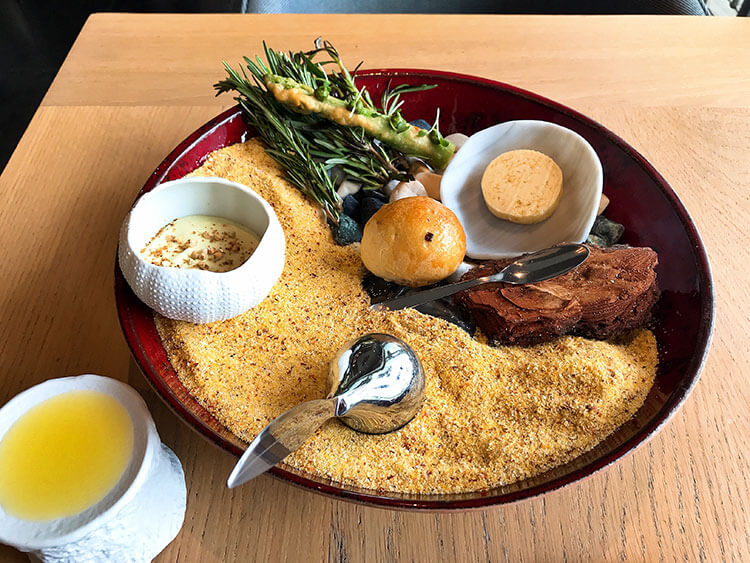
The amuse-bouche arrives and it’s a work of art. It’s a savory “tiramisu” in the shell, a tempura-fried green asparagus just in season from the Landes and bread made with duck. All plated to look like beach meets forest, it’s a perfect representation of the setting of L’Auberge Basque.
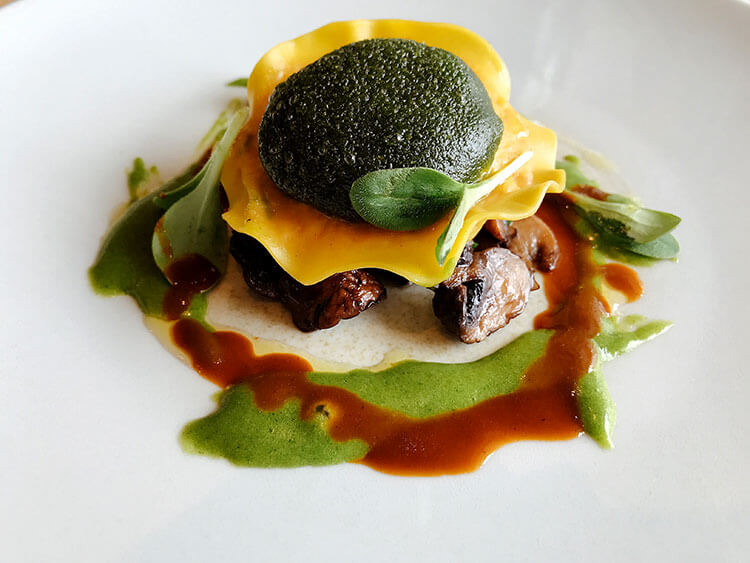
The starter is a beautiful tower: the base a bed of mushrooms and topped with a crab-filled ravioli. It’s crowned with herbs and drizzled with an herb sabayon. Every bite is a flavorful little bit of heaven. It’s paired with a 2016 Domaine Castéra Tauzy from Jurançon.
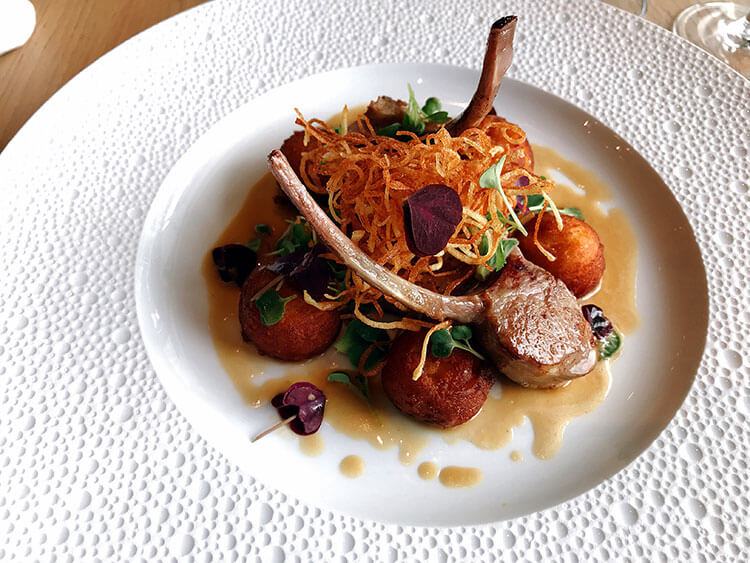
Basque lamb from the farm of Jean Bernard Maïtia, which has been braised in the milk of the meadows, practically falls away from the bone. The lamb chops are served with potato croquettes and topped with fried potato strings. The 2014 Le Village Côte-Rôtie from the Northern Rhône is an excellent pairing.
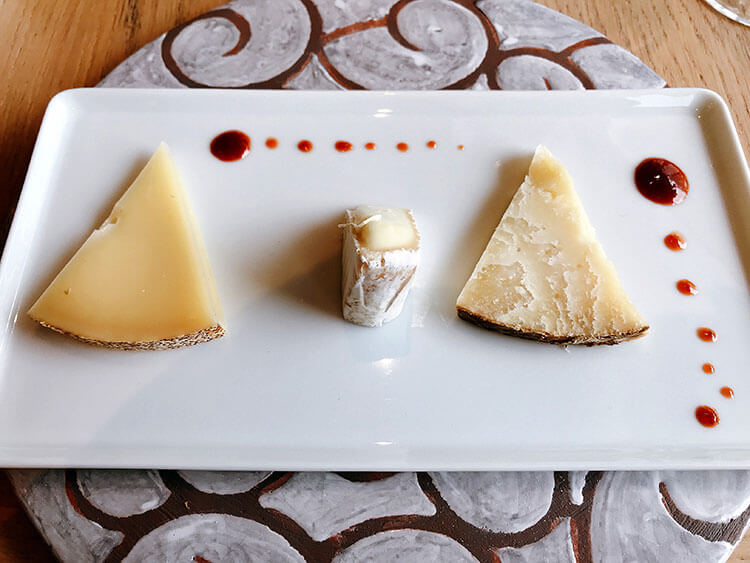
The cheese cart, which has been sitting just between us and the open kitchen, has been taunting us since our arrival. After hearing about all of the Basque cheeses, we choose three. They’re sliced and plated with a delectable Espelette jam.
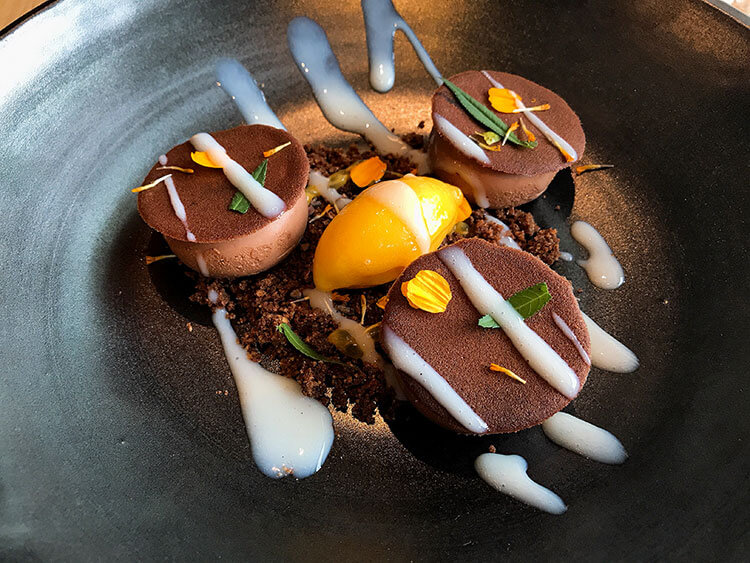
Nearby Bayonne is France’s capital of chocolate and there’s no hesitation that the Basque and Landaise chocolate mousse is what we’re selecting for dessert. The rich chocolate mousse with chocolate crumble is served with mango sorbet. It’s paired with something special, a 2016 Domaine Les Mille Vignges Noir de Carignan, which is actually a type of liqueur produced from the carignan grape.
Of course, if you’ve dined at a Michelin-star restaurant then know there’s never just one dessert. In fact, it’s a trio of mini desserts: chocolate with chestnut cream, a Basque digestive with verbena sorbet, and gâteau basque ice cream with a Basque apple digestive.
L’Auberge Basque La Table, 745 Vieille Route de Saint-Pée. Open Wednesday – Sunday for lunch and dinner from 12:15pm – 1:30pm and 8pm – 9:30pm, and Tuesday for dinner from 8pm – 9:30pm. Reservations required.
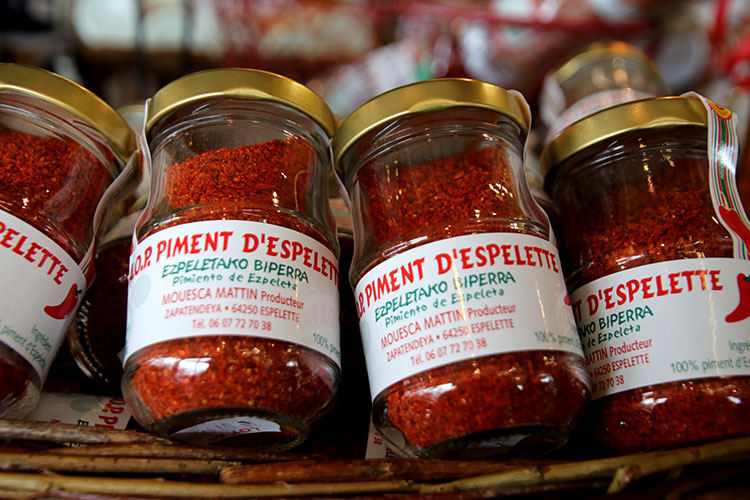
Espelette, France | 10am
If you only visit one village in the Pays Basque, it should be Espelette. Basically the cutest village you ever did see, Espelette is famous for its cultivation of the dark red chili pepper called the Espelette pepper. Just 30 minutes drive from Bayonne, the village is a smattering of half-timber white-washed houses with their red or green shutters and, if you visit during the drying season, strings of the dark red chilis dangling from the facades.
Brought back to France by sailors that were part of Christopher Columbus’ expedition during the 16th century, Espelette is a South American variety of chili pepper in the Gorria family. The sailors professed that the climate and soil of the farmland around Espelette was similar to that of the Gorria pepper’s native land. Farming of the pepper quickly spread.
At that time, spices were a type of currency. The spice trading Moors spread Espelette from the Basque Country in to North Africa, and then it spread further across the Ottoman Empire.
Back in France, Espelette was first used for medicinal purposes. Then the Basque people started to preserve meat with it, covering Bayonne ham in Espelette pepper powder to cure it. Eventually it was used in Basque cuisine as a spice or condiment.
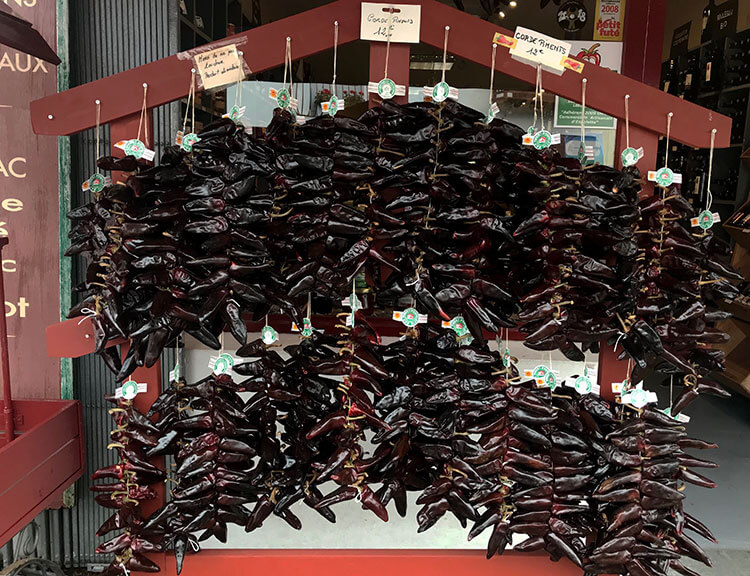
Since the year 2000 the Espelette pepper has been designated a PDO, or protected designation of origin. That means it has strict controls for farming and processing the pepper in order to ensure the quality. Just 10 villages and their fields surrounding the village of Espelette can grow the peppers under the name Espelette. The farming and production of the peppers is still done just as it has been for more than a century.
Once the peppers are harvested each season around September, they are cleaned and sorted one by one. Some peppers will become the Espelette pepper powder and others will be sold whole on the rope. Both are dried usually on ropes of 20-24 and strung up like necklaces decorating the farmers’ houses, but there is also a newer method of drying them flat that speeds up the drying process. Peppers that will be ground up for Espelette pepper powder are put in an oven to cook after the drying period, then immediately ground up in a mill and the powder is put in vacuum sealed bags to await the accreditation of the PDO.
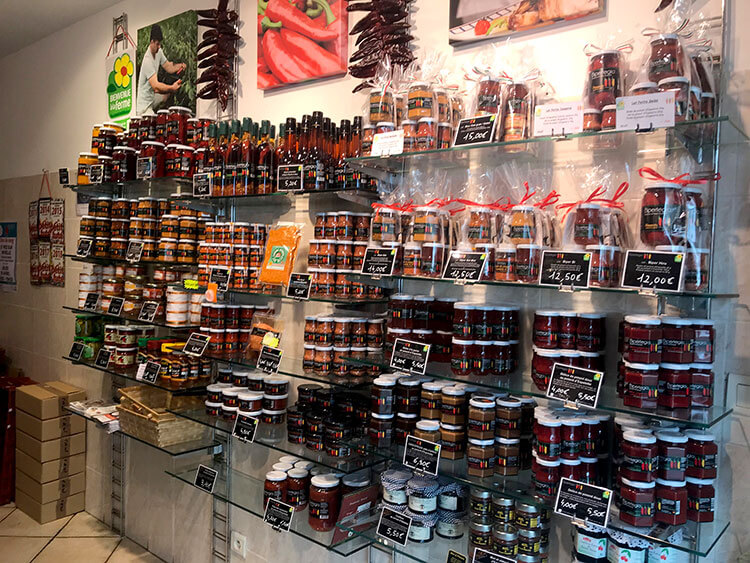
In Espelette, there’s no shortage of shops selling all things chili pepper. From the powder to delicious purees perfect for serving with cheese, the shelves are lined with jars and bottles in little shop after shop. Some even sell saucisson with Espelette or Basque cheese with Espelette. Another sells Basque chocolate with Espelette. Many shops offer little tasting samples of their products. We wander from shop to shop to check out all the offerings, a bag of Espelette goodies to bring home soon overflowing. With a grade of 4000 on the Scoville scale (the scale that measures the heat of chili peppers), Espelette is only mildly hot and a delicious souvenir from your trip to French Basque Country.
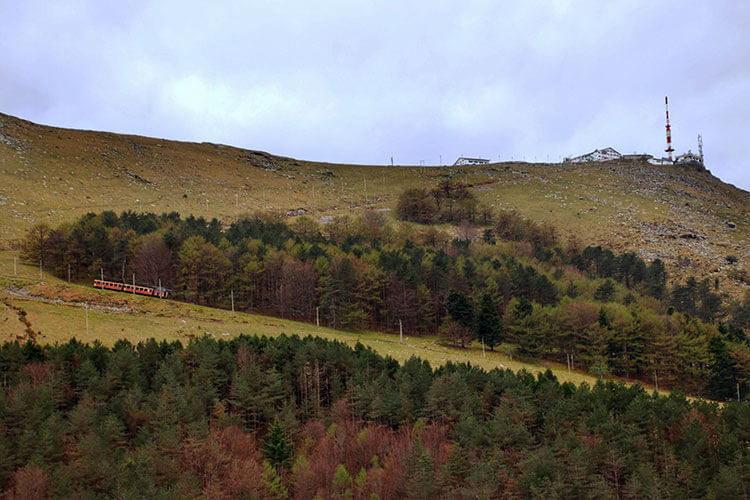
La Rhune | 2pm
Standing at 905 meters (nearly 3000 feet), La Rhune is the first peak at the western end of the Pyrenees. It’s also the symbol of the Basque Country and, when the weather is clear, has an incredible 360° panorama of the seven provinces (four in Spain and three in France) that make up the Basque Country and a stunning view of the Basque Coast. But you don’t have to lace up your hiking boots (unless you want to – La Rhune is the first peak you’ll trek on the coast-to-coast Haute Randonnée Pyrénéenne walking route) to visit the summit.
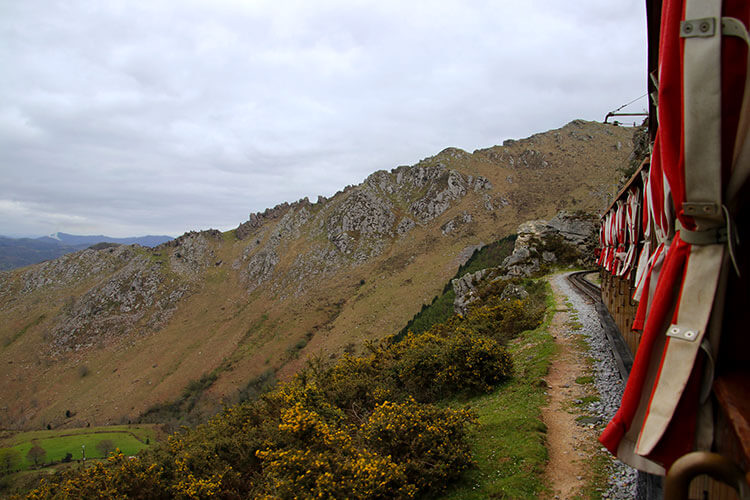
The Petit Train de la Rhune whisks passengers up to the summit on a 35-minute journey on the historic cog railway. The wooden carriages have been restored to their original versions built in 1924 and are a homage to the region with the roof made of Pyrenean fir, the floor made of pine from the Landes and paneling made of chestnut from the Ariège. Riding the train that impressively climbs the steep 18% grades up the side of the mountain is an experience in itself and one of the top things to do in Basque Country.
But it’s not just about the destination; there’s a lot to see along the journey up to the summit of La Rhune. We were most excited to see the Pottok ponies, an ancient breed of semi-feral horses that live here in the Pays Basque.
There’s actually very little known about the original of these adorable small horses, though many believe that is the Pottok that are pictured in the Paleolithic cave paintings in Basque Country. Because of that belief, people say that the Pottok are descended from the Magdalenian horses of 14,000 – 7000 BC.
Once very common in the Pays Basque, the Pottok is now endangered because of lack of habitat and because of cross-breeding with other horse breeds. In 1970 a census was conducted to determine how many pure bred Pottok remained, and it was found that there were less than 5500 at that time. Pottok were officially declared endangered in 1995 and conservation efforts have been in place since to ensure the breed will live on.
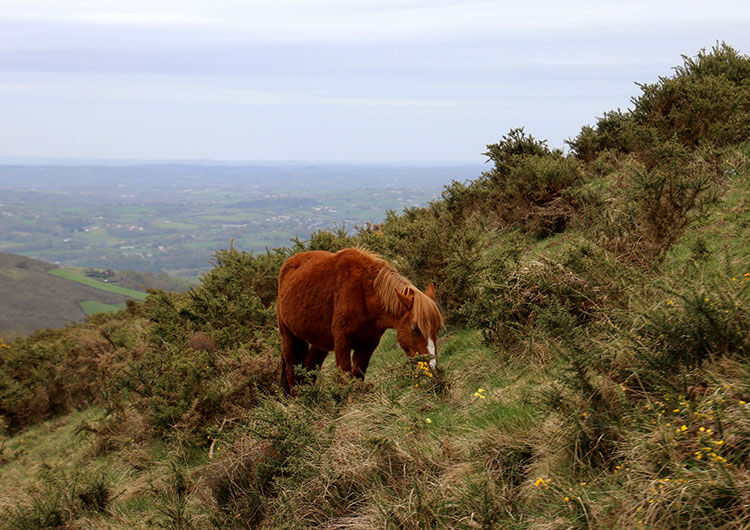
So it’s quite special to see them and one of the best places to encounter Pottok is on the train journey to the summit of La Rhune. They’re semi-wild and a bit shy, but they live and roam in herds of 10-30 horses. Unbothered by the train, they come quite close to the track while grazing on grass and wild flowers. Their small chubby bodies make them forever look like a pony.
Aside from the Pottok, you’re also likely to see manech sheep grazing on the mountainside. They’re the breed of sheep milked to make the AOC Basque cheese Ossau-Iraty. And keep your eye peeled for the vultures that like to circle overhead.
The top is a bit touristy with a cafe and shop selling tourist trinkets, but you have enough time to walk around taking in the view before the train departs back down to Sare. There’s a monument to commemorate Empress Eugenie climbing to the top in 1859.
If there’s enough time and the weather is good, there are hiking trails that lead past the Pottok ponies and to the summit. It takes around 4 hours and 30 minutes round trip when hiking Basque Country to La Rhune. You can also take the train one-way, either first hiking up and catching the train back down or taking the train up and hiking back down.
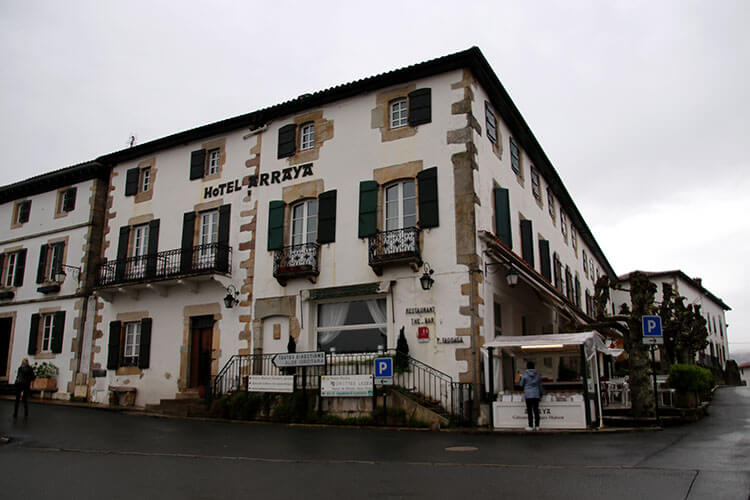
Dinner at Hotel Arraya | 7pm
With a population of just 2500, Sare is almost small enough that you could blink and miss it. But that’s half of the charm, and this unspoiled village isn’t the type of place you’ll find in any guide book. The village is a member of the Association of the Most Beautiful Villages of France, and the red and green shuttered Basque houses couldn’t be more picturesque.
There isn’t a lot to do there, but there are a few shops on the main square. You might also catch the locals playing a game on the pelota court. Or you might just peek inside the Eglise Saint-Martin de Sare with its three stories of oak galleries typical to the churches of the Pays Basque.
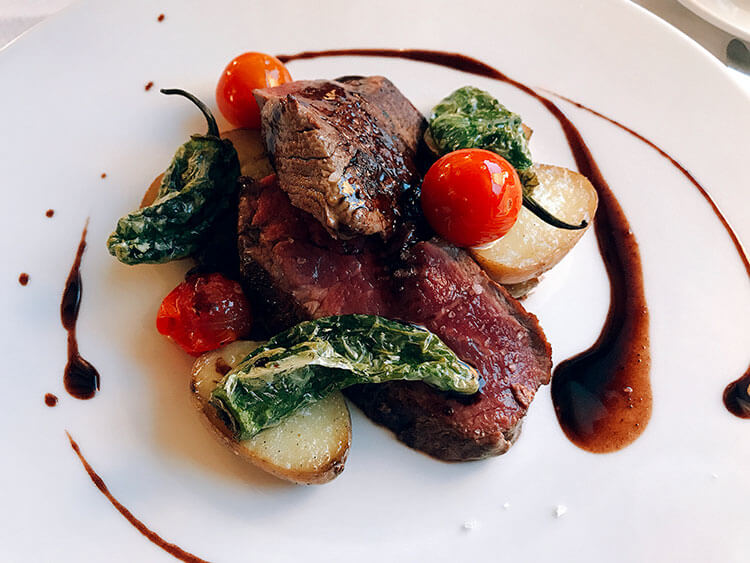
Hotel Arraya is a charming inn located in the traditional Basque village of Sare. It’s wonderfully quiet and the restaurant is an excellent place for dinner in the French Basque hinterland. The hotel has long had a reputation for their delicious cuisine, which of course, offers some of the best products of the Basque Country. When the weather is nice, you can even dine on the terrace under the plane trees. The menu is wonderfully varied with a selection from both land and sea, but it was the filet of beef that was calling our names on our rainy night in Sare.
Where to Stay in Pays Basque
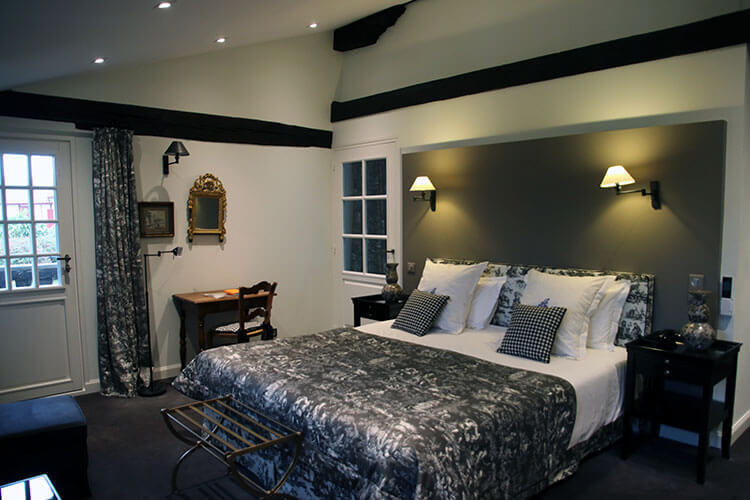
Hotel Arraya
Hotel Arraya in the village of Sare is a perfect base for exploring the Pays Basque hinterland. Close to La Rhune and just 30 minutes from both Saint-Jean-de-Luz and Bayonne, the boutique hotel is a quiet retreat in one of the most charming traditional Basque villages.
Once a traveler’s hostel on the Saint James Way, it was converted in to a boutique hotel in 1951 and has been run three generations of the same family ever since. The hotel is housed in three connected 16th century buildings on the main village square with a secret garden for guests.
We stayed in one of two junior suites called the prestige rooms. These spacious rooms are perfect for a family with a second room for the kids to stay in, and they have private balconies overlooking the secret garden. We even had two Pottok ponies wander in to the pasture behind the hotel while relaxing in our room.
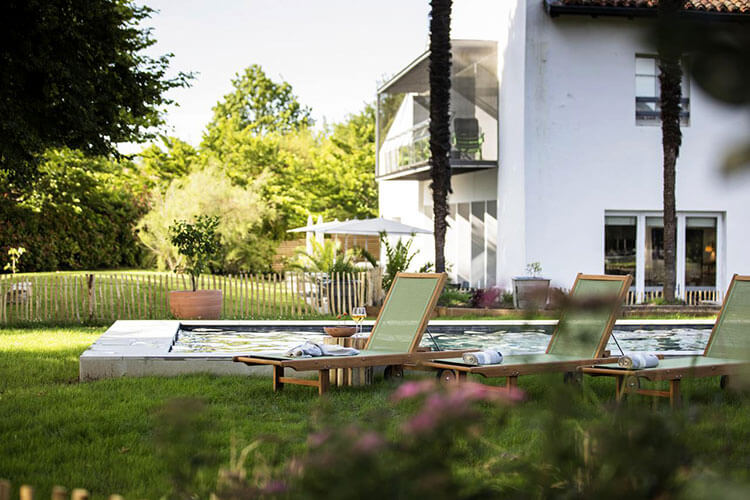
L’Auberge Basque
Located just 7 kilometers from Saint-Jean-de-Luz, L’Auberge Basque is set facing La Rhune mountain. With both the beach and mountains only a short drive, a stay at this luxe boutique hotel affords you country tranquility with popular attractions like the beaches and golf courses of Saint-Jean-de-Luz and Biarritz nearby. It’s also easy to explore inland sights like La Rhune, some of the traditional villages like Espelette and do some hiking.
A 350-year old traditional Basque house is home to the boutique hotel, though the owners have completely modernized the interior with chic, yet simple decor and modern amenities. Some of the rooms have a private balcony with La Rhune views, others have private terraces. There’s also a family room that can easily accommodate two adults and two children.
The swimming pool is particularly lovely if you’d like to take a dip after a summer day of exploring or hiking.
Know Before You Go
L’Auberge Basque offers a slightly more rural setting than Hotel Arraya, set in the countryside on a hill facing La Rhune mountain.
Our trip to Pays Basque was in partnership with Pays Basque Tourisme and Région Nouvelle Aquitaine in order to bring you this story. However, Bordeaux Travel Guide maintains full editorial control of the content published on this site. As always, all thoughts, opinions, and enthusiasm for travel are entirely our own. This article contains affiliate links. When you book through our affiliate partner site, we earn a small commission at no additional cost to you.
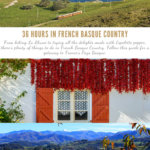
Leave a Reply